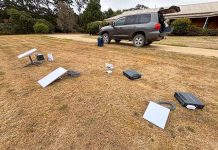Caravans sure have changed over the last five years. The revamped JB Caravans Scorpion Sting is a case in point. From the way it is built to the equipment on board, it is a great example of how caravans no longer have to be a ‘stick and tin’ construction with a few features and comforts on board.
Along with the Gator, the Scorpion Sting is JB Caravans’ top-end offroader. Our review model was 23ft, large and luxurious, with an ATM to match the fact that this rig is built for full-time long-haul travels. This van is not for the faint of heart, or the faint of tow vehicle. This van is unashamedly built for the US ute set. Think Dodge Rams and Chevy Silverados. Let’s hitch it up and take it for a test tow…
NO LIGHTWEIGHT
At Tare, the 23ft JB Scorpion Sting is no lightweight. Our van tipped the scales at 3040kg. You read that right. It has an ATM of 3700kg which, when fully utilised, puts it beyond the reach of the Land Cruisers and Grand Cherokees of the world, and places it in a whole other category of tow vehicle.
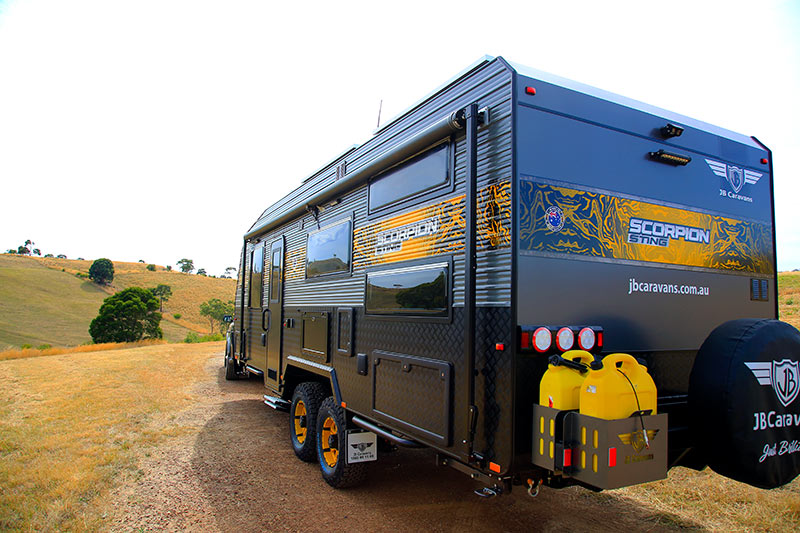 The Scorpion Sting is built atop a 6in chassis, with 6in drawbar and 6in main members. JB has given the steel underbody components a Raptor coating, a durable urethane product that provides a protective barrier against the elements. Not something you see on the average van.
The Scorpion Sting is built atop a 6in chassis, with 6in drawbar and 6in main members. JB has given the steel underbody components a Raptor coating, a durable urethane product that provides a protective barrier against the elements. Not something you see on the average van.
Further, each of the van’s water tanks are properly protected, and that goes for the associated plumbing, too. The storage capacity is 160L across two tanks, plus a separate 65L tank dedicated to drinking water, with a filter included. A 95L grey water tank is also included.
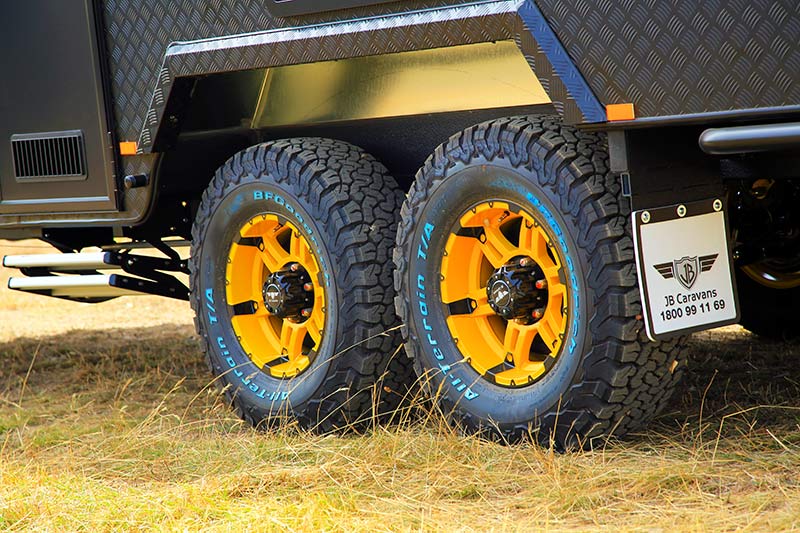 The Scorpion Sting rides on Cruisemaster ATX coil spring suspension rated to 4.5 tonnes, and as expected, JB has used the 4.5-tonne-rated DO45 offroad coupling. At the rear, mounted to the chassis, you’ll find a couple of rated recovery points so that you can extract from the van from the bog, if necessary.
The Scorpion Sting rides on Cruisemaster ATX coil spring suspension rated to 4.5 tonnes, and as expected, JB has used the 4.5-tonne-rated DO45 offroad coupling. At the rear, mounted to the chassis, you’ll find a couple of rated recovery points so that you can extract from the van from the bog, if necessary.
One of the key features of this van is the option for timber-less construction. While you could have meranti framing, JB now offers a special polyresin composite construction. Instead of timber, the framework is constructed from this special material, which won’t rot or break down over time.
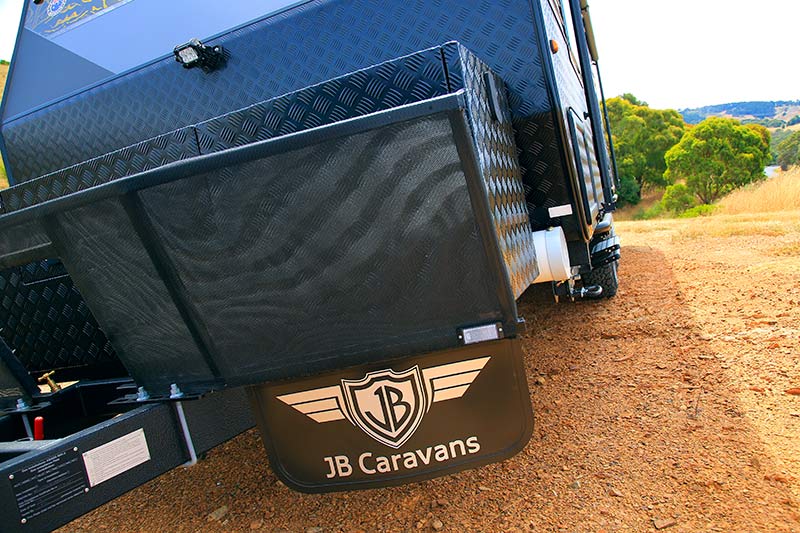 The roof, meanwhile, is framed in aluminium to prevent distortion and maintain the integrity of the roofline, while providing access for future upgrades by the owner. XPS foam – a closed cell structural foam also found in fibreglass sandwich panels – comprises the insulation. This alone is a massive upgrade over the polystyrene many manufacturers still use.
The roof, meanwhile, is framed in aluminium to prevent distortion and maintain the integrity of the roofline, while providing access for future upgrades by the owner. XPS foam – a closed cell structural foam also found in fibreglass sandwich panels – comprises the insulation. This alone is a massive upgrade over the polystyrene many manufacturers still use.
Finally, there’s the one-piece ‘honeycomb’ floor. Complete with an upper and lower skin of woven fibreglass, this flooring system is said to be much stronger than 12mm marine ply, which is also still widely in use, while being 40 per cent lighter. Further, it’s water-resistant, rust and rot-proof.
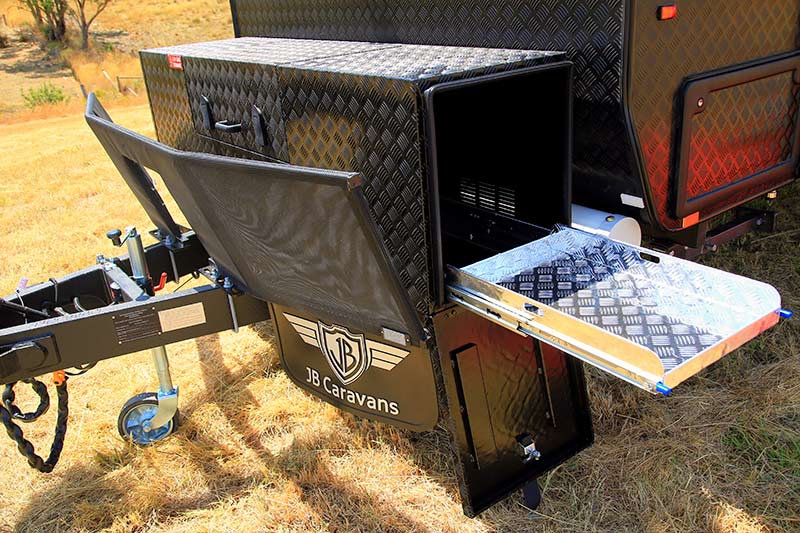 This van does well in terms of external storage, too. There’s a large checkerplate storage box on the A-frame complete with a central locker housing two 9kg gas cylinders, and two slide-out trays either side. Meanwhile, this van had a tunnel boot, a nearside locker towards the rear for external access to the space beneath the bunks inside, a roll-out awning, picnic table and much more.
This van does well in terms of external storage, too. There’s a large checkerplate storage box on the A-frame complete with a central locker housing two 9kg gas cylinders, and two slide-out trays either side. Meanwhile, this van had a tunnel boot, a nearside locker towards the rear for external access to the space beneath the bunks inside, a roll-out awning, picnic table and much more.
JB has mounted a spare wheel and two jerry can holders to the rear bumper, but between the van body and the bumper you’ll find a firewood carrier – an unexpected but welcome inclusion. There is also a reversing camera and LED light bar front and rear.
POWERING UP THE SCORPION STING
The Scorpion Sting offers another genuine point of difference: the electrical system. It comes with a 5kW EcoFlow power system, which equates to about 416Ah of usable energy, along with a 3600W inverter that’s wired to all 240V powerpoints throughout the van. During our time with the van, we were able to boil the kettle and run the reverse-cycle AC unit without plugging into mains.
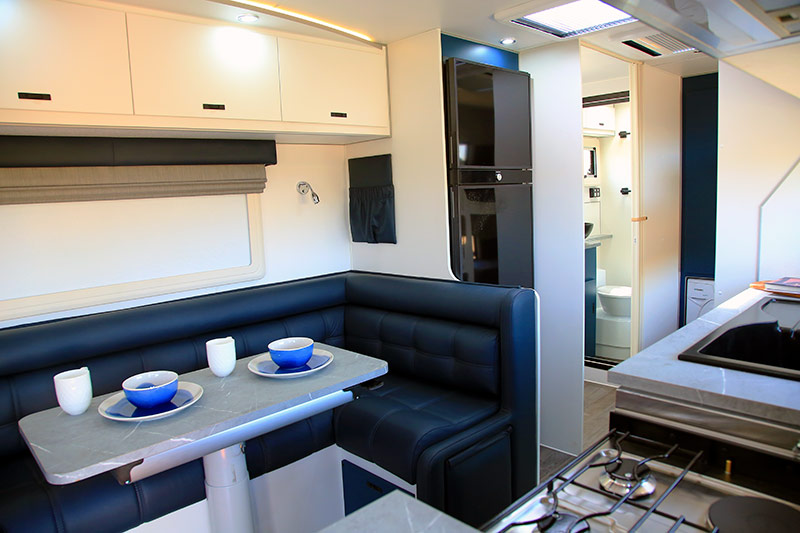 The included control panel is great too. At a glance, this panel provides your energy usage in watts, while also allowing you to operate the lights throughout. At the press of a digital button, you can also isolate the system entirely. Further, you can control everything from a smartphone app.
The included control panel is great too. At a glance, this panel provides your energy usage in watts, while also allowing you to operate the lights throughout. At the press of a digital button, you can also isolate the system entirely. Further, you can control everything from a smartphone app.
All of this battery capacity is going to need to some serious solar input. To that end, the Scorpion Sting has four 200W panels on the roof, and of course the battery system can be charged off mains power as well.
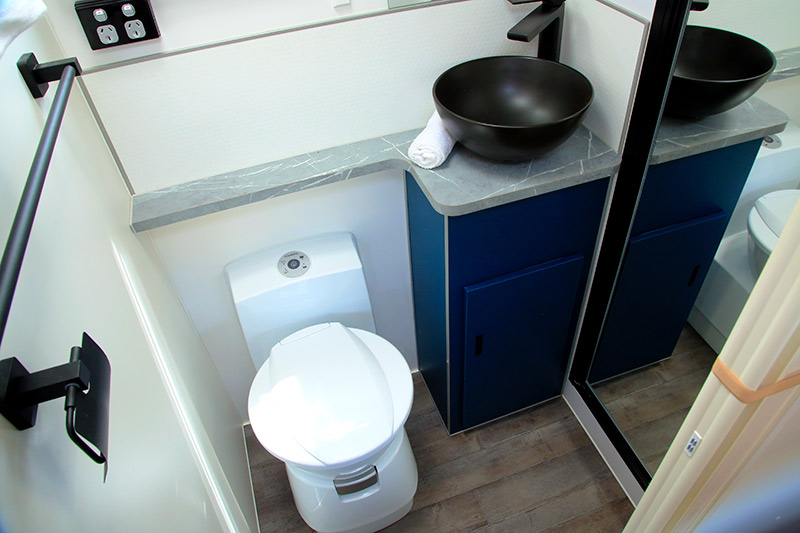 In the rear, you’ll find three bunks in the nearside corner, and an offside-corner bathroom. I liked that the bathroom was positioned on the offside, as that means the toilet cassette can be more discreetly removed for emptying.
In the rear, you’ll find three bunks in the nearside corner, and an offside-corner bathroom. I liked that the bathroom was positioned on the offside, as that means the toilet cassette can be more discreetly removed for emptying.
The nearside club lounge is a winner, too. Upholstered in faux leather, it is particularly comfortable and roomy enough for five people. I liked that JB had fitted a couple of 240V and USB points in the leg well, which should assist in keeping cables tidy when working from a laptop or similar at the dinette.
The kitchen comes with full cooking facilities, including an oven and microwave. There’s a decent spread of storage space as well, while a Fusion sound system is fitted to the cabinetry above the sink. A series of downlights is fitted to the both the kitchen and dinette bulkheads and you’ll of course find numerous skylights.
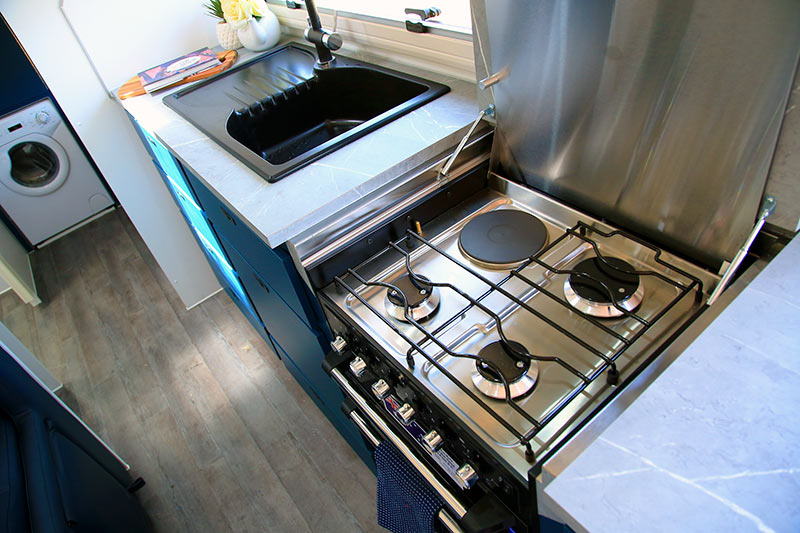 Thanks to the battery and accompanying solar system, the fridge is an impressive 224L compressor unit – much better for tropical touring. JB has also given this van a washing machine, the Dometic Dust Reduction System, and even a Truma gas heater.
Thanks to the battery and accompanying solar system, the fridge is an impressive 224L compressor unit – much better for tropical touring. JB has also given this van a washing machine, the Dometic Dust Reduction System, and even a Truma gas heater.
Meanwhile, the front bedroom is equipped with Sirocco fans, reading lights and charging points. While the Truma heater is mounted in the storage space under the bed, JB has wisely segmented it off so it won’t be damaged by the bits and pieces you’re bound to store there.
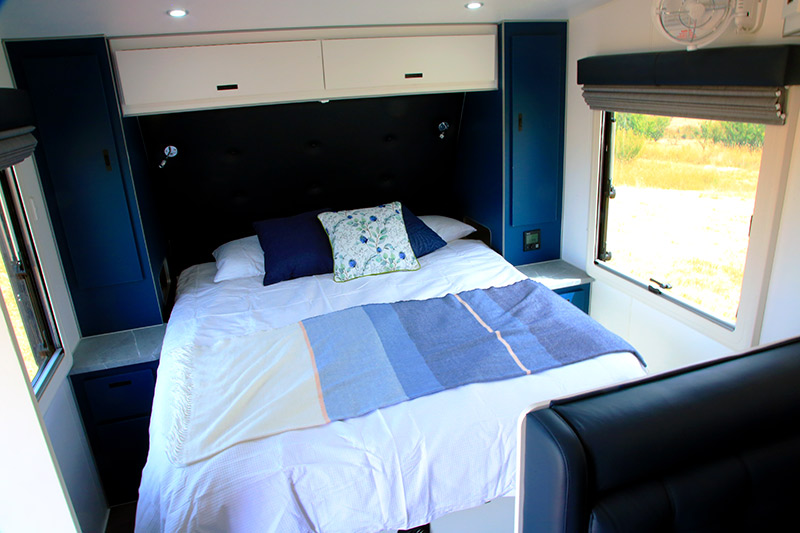 The fit and finish is up there with the best of them – JB has developed a worthy reputation in this regard and the Scorpion Sting is no different. No sharp or rough edges, or exposed screw heads. It is a well-considered and executed interior.
The fit and finish is up there with the best of them – JB has developed a worthy reputation in this regard and the Scorpion Sting is no different. No sharp or rough edges, or exposed screw heads. It is a well-considered and executed interior.
GORV’S VERDICT
There’s no doubt, the JB Scorpion Sting is a substantial caravan. While that is reflected in its Tare weight, the van offers so many features and functions, that it’s to be expected. The build quality is serious, too.
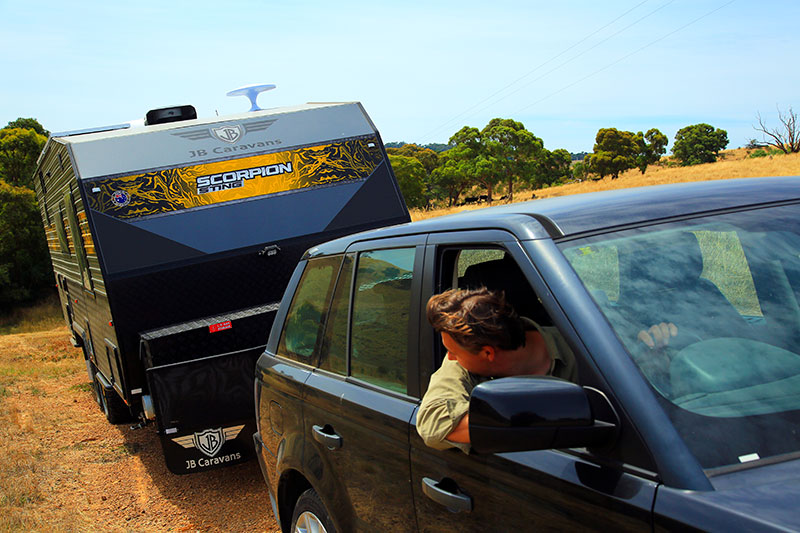 Paired with a suitable tow vehicle, there’s no reason this caravan wouldn’t go anywhere you reasonably wanted to take it. And thanks to the EcoFlow lithium power system, it’s unlikely you’ll ever run out of power.
Paired with a suitable tow vehicle, there’s no reason this caravan wouldn’t go anywhere you reasonably wanted to take it. And thanks to the EcoFlow lithium power system, it’s unlikely you’ll ever run out of power.
THE SCORE
FIT AND FINISH – 
LAYOUT – 
INNOVATION – 
HITS & MISSES
COMPLETE SPECS
Overall length: 9.2m
External width: 2.48m
Internal height: 1.98m
Travel height: 3.1m
Tare: 3040kg
GTM: 3601kg
ATM: 3700kg
Unladen ball weight: 199kg
Group axle capacity: 4500kg
Construction: Polyresin framing (aluminium used for the roof); ‘honeycomb’ floor; aluminium and checkerplate cladding
Coupling: DO45
Chassis: 6in with Raptor coating and 2in raiser; 6in drawbar
Suspension: 4.5-tonne-rated Cruisemaster ATX coil spring
Brakes: 12in electric
Wheels: 16in anodised rims
Fresh water: 1x95L; 1x65L; 1x65L drinking water
Grey water: 95L
Awning: Roll-out
Battery: 5kW EcoFlow
Solar: 4x200W
Air-conditioner: Reverse-cycle
Gas: 2x9kg
Sway control: Al-Ko ESC
Cooking: Four-burner cooktop with griller and oven
Refrigeration: 224L compressor
Microwave: Yes
Shower: Separate cubicle, fully-moulded fibreglass; external shower
Toilet: Swivel cassette
Washing machine: Front-loader
Lighting: 12V LED
Hot water: Suburban 28L gas-electric
TV: 24in smart
Timber-less polyresin construction
Timber-less option: $148,000
Standard price: $142,000




